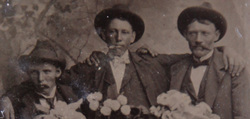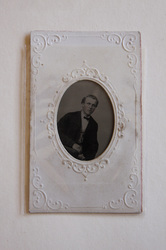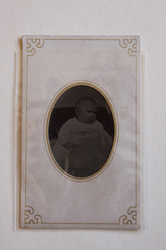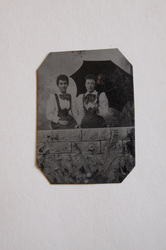 Following up yesterdays post on tintypes, I thought I would share this small collection of tintypes I picked up in Tea, SD back in January. They were sold as a lot of 6. These are among the smaller tintypes in my collection but they are all set within an embossed paper/cardboard frame. While none of these are have any real rarity to them, I did like the various framing on the pieces. You can see that the photos are in a plastic protective sleeve...ones that I have borrowed from my baseball card collection that is still hanging around. My goal in collecting these objects is to one day use them in a history of photography class to discuss the early photographic processes and how photography impacted the general populace, rather than simply focus on the fine art component.
0 Comments
 Of the thousands of vintage photos that I have collected, the tintypes are among my favorite. Today Ive included a small gallery of a few of my collection. I am perpetually astounded by the quality of some of the images...how sharp they are...the beautiful depth of field in some. For an early process, they are remarkable. The size variation is always interesting as well. Not many are more than 2x3 but many are 1x2. I think this variation is at the heart of my love for vintage photography against the standardized formats that I grew up with. Enjoy.  Take a look at this article and images. I am not sure how I feel about this. This photo is one of a number of religious statues remade into the forms of superheroes. I look at this with mixed emotions of humor and enjoyment, and then I turn and feel as if someone has stolen and defaced our sacred symbols. This fickleness in my heart and mind comes from my dual vocation as an artist and theologian. I appreciate the wit, I appreciate the humor. I appreciate the conceptual aspects. But there is something within me that still bothers me. But again I am suprised by the some of the thoughtful comments on the page drawing the ties between superheroes and religious figures. This causes me to ask, where do we draw the line in what is blasphemous? I recently picked up Brent Plate's Blasphemy: Art that Offends. Like most of my amazing book collection, I have not had time to pick it up and work through it. But I hope that when I do, it will help me work through these ideas in an articulate way. The other day I bumped into this article and it reminded me of John Mayer's song 3x5. The life of the photographer is lived behind, rather than in front of the lens. At times, I lament the lack of photos of myself and the many photos I have of other people. Mila's words remind me that I do not need to document everything. And perhaps, those memories will be more precious if I didnt. JUN. 5, 2012 By MILA JARONIEC Last week, I flew to Puerto Rico to visit one of my close friends. I haven’t taken that many pictures because my phone keeps dying while I’m out and I haven’t Instagrammed anything because I’m a cheap bastard who doesn’t want to deal with data roaming charges. The scary thing, however, is the sheer amount of times I have the urge to do just that: to reach for my phone whenever I pass a beautiful building or strip of beach, or snap a photo of some narrow cobble-stoned road, edit it in X-pro II and post it with “San Juan, Thursday 3 p.m.” or some other sh-tty caption. Seriously. The number of times I feel like doing that on a daily basis is staggering. But, damn. I’m not about to pay some crazy amount of money so my Twitter followers can look at the cobble-stoned road I’m walking on; besides, I’m pretty positive no one cares. But we all post stuff like that — martinis, skylines, cats, collarbones, babies, cropped and edited — all over our chosen social media platforms all the time, or when we’re not being charged extra. Granted, it’s not always a bad thing, of course everyone is free to post whatever they want wherever. But in a way, it seems like it’s become increasingly difficult to do anything without feeling the need to broadcast it. Do we do it because we want people to see it, share in it, get a little jealous maybe, or because we have this vague fear that just plainly being in the moment isn’t enough? And I’m not just talking about posting pictures anymore, but simply taking them. About documenting. There’s this crazy sense of urgency about being in a new place, this absolute overarching need to see and do as much as possible and document it in every way you can so you don’t lose it somewhere. Souvenirs. Photos. Receipts, bus tickets. We want to hold onto these things so we remember where we were and when, like we’re afraid our memories might suddenly evaporate; like we’re not experiencing it fully if we’re not cataloging. But in a way, putting too much effort into documenting can make us miss out on what’s really there. Like pinning a butterfly to a display board, we’re so wrapped up in trying to keep it that we lose the raw experience of it entirely. I thought about this when I realized my inability to take tons of pictures or post them was actually a sort of blessing, in that most of the things I experienced and wanted to share weren’t really photo-friendly at all. They were just kind of… lived. Felt. They were things a picture wouldn’t have been able to capture, and even if I had taken a picture, it wouldn’t have been an accurate depiction of the moment because the thousand words a picture is allegedly worth is usually a thousand words of wrong interpretation. I could have taken a picture of my bent copy of Hopscotch blowing open next to a caipirinha in an outdoor café, water droplets sweating down the glass, and it would have seemed the ultimate in tropical vacation relaxation, although at that moment I was feeling empty and desolate at the flat possibility of never being loved again; that and I had a heat migraine. Pictures of books and alcohol always make it look like you’re having some kind of profound alone time even when you’re crushed on the inside and feeling borderline illiterate. I could have taken a picture of myself floating around on my back in the ocean but probably not because my phone would have gotten wet; I suppose I could have asked my friend to do it, but either way you can’t photograph the ocean’s reverberating heartbeat, the deep thrum of the dark water or your own brain melted into one even rhythm when you close your eyes, and that’s the exact moment I wanted to remember. I wanted to take a picture of the art gallery I wandered into, and I did, but not of the owner, who I had a long talk with because I wasn’t late for anything and it was clear she needed the company. Some kid with a giant camera came in mid-conversation and asked if she was an expat, to which she answered “No. Puerto Rico is US territory,” and there was simply no way to capture the way he fumbled with his pamphlet and stumbled over the stair on his way out. And I guess I could have taken a picture of the faded matte blue-gray sky balancing delicately atop the ocean’s flat blackness like a large-scale Rothko, but a phone camera only does so much and sometimes you just have to put it down and look. If you've got a few moments, do yourself a favor and check out this inspiring video. http://vimeo.com/14074949
 I've waited to post anything on Barton for a couple of weeks because I have not known what to say. Barton's death on May 30th caught me by surprise...and yet it did not. I knew he had aids...I knew he had been ill for much of the past year...and well...all people die eventually. But I guess I was just not prepared to say goodbye to someone I felt I had just met. Before coming to ND I had no idea who Barton was, but was quickly introduced to his work by fellow students and faculty. While Barton had friends and collectors across the country no doubt, peculiarly he had a pocket of friends, admirerers, and acquaintances in the Red River Valley of North Dakota. It is through these connections that I had two opportunities to meet him. First, on our print trip to NYC in the fall of 2011, we stopped in to his apartment and studio for a few hours and chatted with him. It was such a remarkable space filled with art and artifacts that bespoke of Barton's imagination, creativity, sense of humor. He welcomed us in to his cramped home as if we were long friends. The second visit (from which this photo was taken) spoke more to me about the man than I could have expected. Sundog Press, here at UND, did a print for Barton...a prayer rug made from stamps. It is a beautiful peice. I was headed to NYC to speak at the College Theology Society annual conference and it worked that we could meet up and I would assist Barton in signing and dividing up the prints. It was a great 3 hours or so. Not only did we snoop around his place, look at the artifacts again, see his new work, but he bought us dinner, answered my silly questions, and even discussed religion with me (I have in mind to do a paper on Barton's religious imagination some day). I will be the first to say that I did not know Barton well. But it is strange how in the course of two short visits, this man came to impact my life in such a unique way. His sense of humor and hospitality was remarkable as was his generosity. I am truly thankful for those brief hours with him, it was the highlight of our trip to NYC, and those memories will linger on shaping my life and art practices from here on out. Thank you Barton for your courage, humor, challenging us with your work, and your gracious spirit. For more about Barton, check out this recent article by the NY Times.  A while back I did a little work on another Cabinet Card that was actually a lot of fun for me. I love giving these objects a bit of a historical context and the Cabinet Cards are especially open to these sorts of investivations. This card was received in the same lot as the others a few months back. Once again we set the time period of production between the 1860's and 1900. So here it goes... Our photographer looks like A Hellmuth from Aschersleben (or Alsleben as both places are listed on the front of the card). But sadly that is all the information I can find on the man. Ancestry.com does list several German born A Hellmuth's in the 1930 American Census. But without a full first name it becomes much harder to make any sort of conclusion about an immigration. Neither do any of them list photographer as their profession, though that may well have changed within a move to a new land where you do not speak the language. So...Moving on... Starting with the top line "Atelier fur Malerie und Photograpihe" = Studio for Painting and Photography (I actually wonder if this is a typo on the "photograpihe" on the card instead of "photographie"? In the banner under the name it lists both towns Alsleben a/Saale (Salle is the river on which the town is located) and Aschersleben. Under this, the address of Markt 25 is listed. Assuming streets and names have remained the same, see it here on Google Maps. On the left panel it reads, "Portraits, Gruppen, Kinder, Moment, Aufnahmen, Reproduction, Gemalden etc., Specialitat: Vergrosse(?) nack jedem bilde auf pigment bromsilber, platin papier etc. Zusammengeserzte Gruppen, Vereins Tableaux, Deinecte Aufnahmen bis Lebensgrosse, Malerei in Jeder Ausfuhrung." While Google Translate cant figure everything out, it comes back as "Portraits. Groups. Children snapshots. Reproduction for paintings, etc., Specialitat:Enlarge to every fancy of pigment-bromide, platinum paper, etc. Zusammengeserztegroups (?). Association tableaux. Direct recordings to life-size painting in any execution." The bottom line reads, "die platte bleibt aufbewahrt" which means "the plate is kept" and numbered into the photographers inventory for future reproduction. Within the scroll is the term "widmung" which translates to "dedication" hence the wonderful handscript, which I cannot read save for the name Margaritte. If you can read German handwriting could you make out that translation for me? Well, without finding much on the photographer himself, it is hard to go on much beyond the facts on the card itself. I do still find them fascinating and there are more coming up in the next month or so that I will be looking at as I have time. This has been making the rounds on FB, but it is too good not to share once again here. As a child who grew up with Mr Rogers, I find him still inspiring today. What a remarkable invitation to engage the beautiful mysteries of the world. Thanks again Mister Rogers!  Last week I had the priveledge to attend the joint meetings of the College Theology Society and the National Association of Baptist Professors of Religion. I believe this was my 5th meeting that I have attended. One week ago today I was skimming through my paper in preparation to present it at 9:30. This was also my first real trip to Texas (clipping the corner en route to New Mexico in 8th grade didn't count). It was somewhere in the low 40's in ND when I left at 7am but was around 90 when I got to San Antonio at noon. I will say that I doubt Texas will ever be for me. Between the rattlesnakes and the heat, and other crawling things, it makes me thankful to be a resident of the upper midwest where the winter prohibits much of those forms of life. That aside, it was a nice visit and a great conference. Between AAR and CTS meetings, I have now attended enough conferences to be at the point where I no longer feel guilty about skipping sessions. I have sat through enough sessions that were either or both outside of my knowledge range or just over my head that it really was a waste of my time. I now take advantage of naps. I was thankful that my paper was given the first session slot, because I could sit back and enjoy the rest of the conference. I have been on the last Sunday session and not only is attendence usually down as people are already heading home but the anxiety of pushes me to noodle my paper right up until I present. My paper was entitled "Jesus Gave Me This: Deciphering the Overlap of Spiritual Language in the Creative Process" The paper largely grew out of my experiences with a Christian artist group who's members would speak about the source of their creative idea with theological language suggesting both personal revelation and inspiration. They used these terms in a variety of ways from meaning a general urge to create but also that God spoke to them and gave them the creative idea and even created the work through them. The paper then goes on to explore a variety of issues such claims make for both theology and the arts. Since I have returned I have been working on edits to the paper so it can be submitted for consideration in the conferences annual volume. While it is nice to be asked to submit the paper, the quality of papers suggests that it is not likely to be accepted. Oh well...the struggles of editing are always good practice for developing ones writing. My experiences of conferences are usually a mixed bag. I am often inspired by the work that is going on and how it relates to mine. But I often feel so intellectually inadequate among so many well educated people. Of course many of them are well along in their careers and have books and PhD's. It is about this time when I go back to my room to take a nap which usually rights the world again. The book publishers tables are always a highlight as are the socials and the meals out with friends that I get to see only at this conference. Some conferences can be stuffy and stiff, but this conference is always warm and welcoming. It is a great place to try out new stuff because people are affirming and encouraging, particularly for graduate students. If you looking for a conference, particularly if you are interested in either Baptist or Catholic theology or ecumenism, then CTS is a perfect conference to check out. And a plug for next year...its at Creighton in Omaha Nebraska. |
Ryan StanderArchives
January 2018
Categories
All
|













 RSS Feed
RSS Feed
